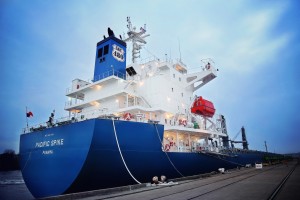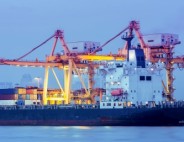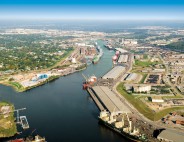
Seaports are the Heart of Nation’s Freight Network
03 Aug, 2015
Caption: Activity at the Napoleon Terminal at the Port of New Orleans, Louisiana. Photo courtesy of AAPA
By Rachel Duran
Crumbling landside connections threaten nation’s seaports.
Private and public partnerships at seaports are generally working well, making investments of more than $9 billion annually in facility enhancements. This figure is based on surveys of American Association of Port Authorities (AAPA) members in a report released earlier this year. Such enhancements are taking place at seaports throughout the country, including in Florida at the Port of Palm Beach and Port Everglades/Broward County; and at the Port of Stockton, California.
Infrastructure improvements range from replacing bridges, enhancing rail and intermodal services, deepening and widening navigation channels, adding berths to accommodate expansion, widening highway lanes, and preparing industrial land to support expansion projects, just to name a few improvements.
But what is not working as well is steady and consistent federal investments to connect infrastructure from the waterside to the landside of the ports. Many of these first and last mile connectors are antiquated, in disrepair and lead to traffic congestion.
Members of the AAPA say $28.9 billion is needed for 125 port-related infrastructure projects around the nation by 2025. “The ability to move into and out of the ports and to the connecting transportation infrastructure is absolutely vital for our economy,” says Kurt Nagle, president and CEO, AAPA.
The numbers tell the tale. In the recent study by Martin Associates found that 26 percent of the nation’s economy comes from maritime economic impacts, which equals $4.6 trillion, 23 million jobs, and more than $320 billion in tax revenues at the local, state and federal levels.
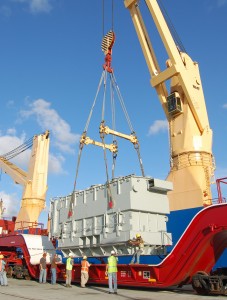
Port of Palm Beach, Florida, import of transformer for Florida Power & Light. Photo: Port of Palm Beach
“These necessary road, rail, bridge and tunnel improvements are crucial to enable our seaports to efficiently handle their expected cargo volumes, continue providing dramatic economic and job impacts, and enhance America’s international competitiveness,” Nagle said earlier this year in a public statement.
Traffic congestion is on the rise at landside seaport connectors, which is hurting productivity. One-third of respondents to the study by Martin Associates stated congestion at landside connectors over the past 10 years has caused productivity to decline by 25 percent or more.
There are encouraging federal policies at play to support needed developments. Last year the Water Resources Reform & Development Act was signed into law, stating funding targets during the next 10 years would move the usage of the federal Harbor Maintenance Tax to 100 percent in order to fully utilize the tax to better maintain harbor channels. Up to this point, there has been a relatively low use of the maintenance tax collected on the goods moving through those channels on port infrastructure improvements.
The Move America Act 2015 calls for infrastructure bonding and credits legislation, which would assist in funding landside improvements in order to enable greater investments through public-private partnerships.
A continuing challenge to funding is the federal Surface Transportation Bill (MAP 21), which was set to expire on May 31. The bill was extended to July 31 of this year after legislators failed to agree on how to fund an extension through the end of the year in order to buy time to form a package for a multi-year bill.
Not Waiting for the Feds
Port authorities across the country are moving forward with public-private partnerships to develop efficient infrastructure. The Port of Stockton is one of the state’s lesser known assets. The port has a number of infrastructure projects underway including replacement of the bridge that provides direct road access to the port’s West Complex Facility. Additionally, the rail grade separation is being widened where the BNSF main line intersects Navy Drive; as well as widening the drive to accommodate Interstate 5 on and off ramps that terminate on the road.
Rail infrastructure improvements also include the addition of 22,000 lineal feet of class yard interchange track, allowing for up to 12 unit trains plus manifest business per week, writes Mark Tollini, senior deputy port director, in an email correspondence. In 2014, more than 96,000 rail cars were handled on port-owned tracks operated by the Central California Traction Co., a wholly owned subsidiary of UP and BNSF.
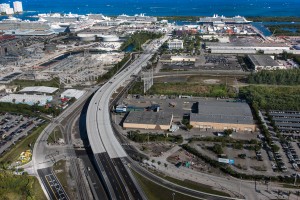
Port Everglades, Florida, is the No. 1 container port in the state, annually handling more than 22 million tons of cargo and nearly 4 million cruise passengers. Photo: Port Everglades
Tollini notes UP has constructed a ribbon rail-welding facility on port property and is receiving 480-foot lengths of bundled rail from Japan, which is discharged directly from the M/V Pacific Spike vessel to a series of shuttle cars and then to its destination.
The Port of Stockton operates on more than 2,000 acres of property adjacent to the Stockton Deep Water Navigation Channel, between the port’s east and west complex facilities. There are 15 berths and more than 12,000 lineal feet of on-dock rail, which is attractive to heavy-lift project cargoes. The port also handles more than 1 million metric tons of nitrogen fertilizers, both dry and liquid.
Meeting Freight Volumes
By 2025, it will take an estimated $28.9 billion in 125 port-related infrastructure projects to support freight connector needs in order to handle the country’s port freight volumes.
North Pacific Ports: $6,925,300,000
South Pacific Ports (includes Saipan): $6,508,102,500
Great Lakes Ports: $332,698,000
Gulf Ports: $4,134,670,000
North Atlantic Ports: $6,413,982,644
South Atlantic Ports (Includes Puerto Rico and U.S. Virgin Islands): $4,637,500,000Source: “2014 National Economic Impact of the U.S. Coastal Port System”
Moving to the East Coast, at the Port of Palm Beach, infrastructure enhancements include renovations to slip number 3, which were to be completed June 1. Another project is the addition of more highway lanes to the Martin Luther King Jr. Boulevard, which runs through one of the port’s main entrances.
The port is one of three major seaports in South Florida, and is nearly 60 miles farther north than the closest southern port. In partnership with the Florida Department of Transportation, a $26.5 million project replaced sheet piles at slip 3, the addition of new sea guards, and deepening of the berth to 37 feet from 33 feet. “On the north side of the slip we replaced railroad ties and enhanced the rails,” says Manuel Almira, director, Port of Palm Beach. “We have our own short line rail and we interchange with the Florida East Coast Railway.”
The Florida East Coast Railway is the exclusive rail provider to South Florida’s ports providing end-to-end carload and intermodal solutions. It spans 351-miles along the state’s east coast and interchanges with two Class I railroads in Jacksonville.
At Port Everglades, a partnership formed between the Florida East Coast Railway, the state and Broward County. The Intermodal Container Transfer Facility opened in July 2014 at the port. “It is the only facility of its kind in the country in that it handles both domestic as well as international cargo, with two separate gates to the facility,” says Steven Cernak, CEO, Port Everglades/Broward County. “So local manufacturers have the opportunity to ship their goods via rail into their markets in the United States.”
The Florida Department of Transportation has invested in improving road connectivity to the port. A new road opened up as a result of the railroad, a $42.5 million project that brought Interstate 595 into the port; an overpass goes over the rail. “Relocating access to the port away from the convention center [which is located on port property] so that traffic flows into the convention center, means it no longer has to go through security,” says Ellen Kennedy, assistant director, corporate and community relations, Port Everglades.
The port is an enterprise of Broward County and receives no direct tax support. “We are fortunate enough that we have enough money left to reinvest in our facilities,” Cernak says. The port is the No. 1 container port in Florida, and No. 12 in volume in the United States. The port is also the No. 1 seaport for exports in the state. “We are a 50-50 blend, which is unique at U.S. seaports because the country is predominately a consumptive nation so you mostly see imports come in,” Cernak says. What’s more, 50 percent of trade with Latin America flows through Port Everglades. The port is also the No. 2 petro port in the state, serving 12 counties, including three international airports.
Infrastructure at the Port of Palm Beach features rail services on the north side of slip 3, which moves, among other products, machinery including generators and transformers with final destinations to Miami, Orlando or in the glades area where Florida Power & Light built a new energy facility. Moving such equipment from the Port of Palm Beach saves time and money; otherwise the equipment would be unloaded at a northern Florida or southern Georgia port, adding time and cost to move the products to the destinations.
“The Port of Palm Beach is the only port in South Florida equipped with the infrastructure to load barges with raw sugar, which is moved to the East Coast,” Almira says. “This infrastructure prevents the need to move the sugar by truck on highways.”
Almira says the upkeep of the thoroughfares is just as important to the Port of Palm Beach. Through the use of eminent domain, the Florida Department of Transportation has been purchasing property on the port’s south side to accommodate future growth and enhance traffic in and out of the port. “We had 254,000 TEUs; the majority came to us via truck,” Almira says. “A little more than 10 percent came via rail.”
One of the reasons is the port is mostly an export port, which handles 40 percent of the food cargo destined for the Caribbean Islands. “Much of the food is purchased somewhere in South Florida,” Almira says. “This places a major need for the upkeep of the thoroughfares.”
City of Stockton, Calif.’s Hidden Gem
By Rachel Duran
The Port of Stockton is a bit of an unknown when it comes to West Coast seaports. As a major inland deep water port in California, the port is equipped to offer the services found at the state’s larger port facilities.
The Port of Stockton is surrounded by agriculture commodities, located in the middle of California’s central San Joaquin Valley, “the center of the ag universe, shipping those commodities around the world,” says Micah Runner, director of economic development, city of Stockton. “And we bring in fertilizer to support the ag sector.”The Port of Stockton operates on more than 2,000 acres of property near the Stockton Deep Water Navigation Channel.
In regard to efficient goods movement in and out of the port, Runner says officials have enhanced highways and are developing solutions to support the movement of heavy container loads from the port to the area’s industrial parks.
From a broader community standpoint, economic development officials are ready to assist companies. Runner says there are a variety of incentives to support investments, including a 50 percent reduction on impact fees for new commercial or industrial uses. “From the city’s perspective, the port is a vital resource and contributes to the continued ability for the city to expand and grow and create new jobs,” Runner says.
For more details, visit www.stocktongov.com.
“Our largest tenant, Tropical Shipping, has multiple sailings on a weekly basis to just about every island in the Caribbean,” Almira says. Tropical Shipping has been recognized as having one of the most efficient container terminals in the United States. The company moved more than 7,400 TEUs per acre; the average on the East Coast is 2,300 containers to 3,500 containers per acre, Almira notes.
Back at Port Everglades, infrastructure enhancements are almost wrapped up. “All of our landside projects will be complete this summer,” Cernak says. “I am concentrating on the water side.” Projects include the expansion of the South Port Turning Notch, which is needed to add berth capacity and further facilitate the turnaround of larger vessels. Port officials want to increase the depth from 900 feet to 2,400 feet, creating five additional berths. The project is estimated at $182 million, some of which will come from the state and some from the port.
Another project is the deepening and widening of the Port Everglades channel, which was authorized by the U.S. Congress back in 1996. “We are on the final approach, going toward the design and then construction,” Cernak says. The project is estimated at $374 million, with costs being shared by the federal government and the port.
An interesting fact about Port Everglades is that only 7 percent of its cargo in 2014 came from Asia. The port’s trade lanes are predominately north-south, serving the Mediterranean, Europe, Central America and South America. Those large vessels already trend at the Suez Canal, Cernak notes, so vessels are coming into the port light loaded, or high out of the water. “It is not the most efficient way to move these ships around,” Cernak says. “The larger ships cause congestion problems in the channel so the widening of the channel is a priority.”
Another expansion project is the widening of a slip to increase vessel capacity in order to keep fuel flowing for South Florida. The port handles 12 million plus gallons of fuel a day. The completion date for the $84 million project is January 2019.
Says John Martin, president of Martin Associates, which published the study on the impact of the nation’s seaports: “The growth in the contributions of our ports to the nation’s economy underscores the need to invest in infrastructure and technology to support and foster good jobs, national security, international trade and our standard of living.”
For complete details on the organizations featured, visit:
American Association of Port Authorities


